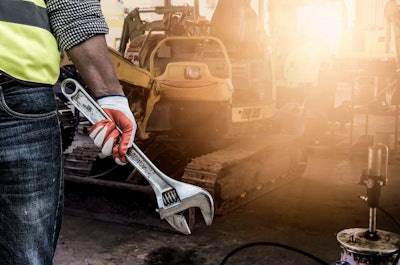
The Service by the Boxes methodology is a set of core values, fundamentals, or perhaps foundational principles. It aims to decrease the number of days a work order takes to close, increase technician recovery, and increase technician billing efficiency.
The Service by the Boxes methodology proposes that the service process can be divided into as few as 10 distinct stages, which I prefer to refer to as boxes. Thus, the title of my first book is “Service by the Boxes." Additionally, this methodology indicates that specific actions must be completed to move the work order to the next box; without these actions, there is a risk that the work order could be prolonged or, in the worst-case scenario, may stagnate. And the dealership will have to write it off. Furthermore, accountability is crucial for the success of the Service by the Boxes methodology. One individual at the dealership must be responsible for each required action; without accountability, the successful implementation of Service by the Boxes in a service department is unlikely.
These three fundamental values or principles will enhance a dealership’s profitability and cash flow. This approach is also simple, understandable, and accountable.
One box embodies these three principles and displays their importance more than any of the others. This box, or stage of the work order process, will have the most significant impact on decreasing closure times and increasing technician recovery and billing efficiency. This isn’t to say that improvements can’t be made in the three areas—days to close, technician recovery, and billing efficiency—without excelling in this one box. However, this is the simplest and most efficient way to enhance them and drive customer satisfaction.
The Service to Be Estimated Box
The Service to be Estimated Box is crucial for ensuring the success of the Service by the Boxes methodology at your dealership. Service managers often push back on this box. I’ve had many discussions about it, and there appear to be three reasons why.
The first reason there’s a lot of pushback on estimating every repair is that the service manager doesn’t truly understand the importance and precisely what we are saying or asking for when we tell them to estimate every work order. I have talked to other consultants and successful service managers believe in quoting every job. I’m not in favor of quoting every job, and there are multiple reasons why, but I will discuss a few here.
The first reason is that quotes are absolute, making them tricky to get right. When you quote a job, you increase the chances of not completing it within the quoted parameters, whether due to the technician needing more time, additional parts being necessary, or the machine being misdiagnosed. While quoting a job raises the likelihood of failure, I will admit that it’s much better than not quoting or estimating a job at all.
Service managers often hesitate to provide estimates for a job because they fear being wrong; they don’t want customers to view them as incompetent. The advantage of giving an estimate is that it recognizes our limitations, which is completely acceptable. Customers don’t expect us to know everything. This is why I strongly recommend estimating every job. An estimate is simply our best guess of what the repair cost could be. We’ve done well if we remain within 10% to 15% of the estimate. If we exceed that 10% or 15%, that's when we should contact the customer with an updated estimate.
Regardless of how long you’ve been in the business, you won’t know the exact cost of every service repair. Don’t mistakenly think it’s your job as a service manager to know everything about every machine; that’s simply not true, and customers do not genuinely expect that from you. This expectation will increase your stress and diminish your job satisfaction to the extent that you might feel like a failure as a service manager for not knowing everything about every piece of equipment. In reality, that’s just unrealistic.
When we estimate a job instead of quoting it, we gain flexibility and reduce repair time since we don’t spend days perfecting our quote. We aim to be in the ballpark—by that, I mean within 10% to 15% of the estimate. This allows us to follow up with the customer more quickly to obtain approval, order the parts, and begin the repair.
The final reason service managers don’t estimate every job is that they hold a misguided view of their responsibilities or, more accurately, of the purpose of the service department at a heavy equipment dealership.
Having the Right Perspective
Service managers who struggle with estimating every service repair tend to have a technical mindset rather than a business perspective. They believe their role is to repair and keep every customer’s machine operational. This shortsightedness can lead to significant frustration for the service manager. This frustration arises for both the service manager and your service department because they will never complete their job. They will find it impossible to achieve success, as no matter how hard they work, they cannot have all customers' machines running simultaneously.
The purpose of the service department is to maximize the dealership’s profits, which it accomplishes by repairing equipment. From this perspective, the service manager sees customers not as obstacles to success but as opportunities to increase profitability and cash flow for the dealership.
By changing their perspective, your service manager or service department will feel excited when another customer calls or brings in additional equipment for repair. This shift will help them realize that the customer’s calls increase their opportunities for success, ultimately leading to greater profits for the dealership. However, it can be demotivating and frustrating if they view their job solely as fixing customers' equipment whenever a call comes in. No matter how hard they work, there will always be another customer needing assistance. They miss out on enjoying the fruits of their labor and the sense of achievement, which leads them to believe they’re failing and letting down both the customer and the dealership.
When service managers understand their purpose and responsibilities at the dealership, they realize that estimating every job is the most valuable tool in their toolbox for driving profitability, cash flow, and customer satisfaction.
The Power of the Estimate
The service department is unique in that customers often have little knowledge about repair costs or the parts required for repairs. This scenario grants the service manager significant power, which must be exercised with caution to avoid potential abuse. Essentially, the service department sets the pricing for their services without encountering competition. When a salesman offers a quote for a new excavator, the customer has the option to compare it with quotes from other dealerships. Likewise, when the parts department provides a parts quote, customers can check prices online or contact a nearby dealership for comparisons. The service department stands out because once a machine is brought in and an estimate is given, it becomes very difficult for the customer to load the machine back up and seek an additional repair estimate from another service department.
As I mentioned, this great power must be used with great caution. We do not want to exploit or deceive our customers; they will ultimately seek another dealership. However, we must acknowledge that customers often lack a clear understanding of repair costs. Throughout my career, I have learned that regardless of the price provided, customers consistently claim that the dealership is overcharging them.
Recognizing that we may be accused of providing an excessively high estimate to our customer, we should approach every job with a broader estimate range, effectively addressing those accusations. This should be done ethically and morally, while acknowledging that there isn’t a specific value for each job; instead, there is only a range of possible values for each job. This is a business transaction, and we are negotiating with the customer.
Every customer values repairs differently based on their circumstances. A customer with a job site shut down and losing $20,000 a day will attach a higher value to machine repair than a customer using it for personal purposes on their family farm. As I mentioned earlier, we must estimate our repairs ethically and morally; however, our primary job is to generate profit for the dealership and, secondly, to provide a service to our customers. To clarify, what I’m about to express is both ethical and moral. When you fly on an airline, if you want to board the plane first, you can pay more for that service; if you desire a larger seat with more attentive treatment, you can spend more to fly first class. These are standard and accepted business practices carried out every day in our country, and nobody questions them at all.
The customer losing $20,000 a day is willing to pay a much higher price for their machine repair than the customer who does not need it urgently. The customer using the equipment for recreation is not losing $20,000 a day. It would be unethical to treat the recreational customer the same way we treat the customer losing $20,000 a day. However, if we give preferential treatment to the customer losing $20,000 a day at the same price offered to recreational customers, it would be wrong. It would be akin to charging a business-class flyer the same price for a first-class ticket while not allowing them to sit in first class. I hope you understand my point.
The estimating process is simply a negotiation process. We need to understand our customers and their needs. The greater the demands, the higher the estimate will be. Time is money, and money is time. If a customer absolutely must have it, we will provide it and move heaven and earth, but they will pay for it. If a customer is willing to wait, we will offer them a great deal, but we will address it at our convenience.
Why Do We Estimate?
As I mentioned earlier, service managers often do not estimate jobs because they don’t fully understand the process. An estimate is not a “sniperistic” (yes, I just made up a word), but rather a shotgun effect. I want to reassure all service managers that they will never know the exact cost of each repair. We provide an estimated cost and inform the customer that we should be within 10% to 15% of that estimate.
I learned this principle from construction companies: when estimating the cost to build a building, a parking lot, or anything else, they provide an estimate. They offer an estimate because they lack knowledge about what lies beneath the earth. They are unaware of the soil type or any potential issues they might encounter. What they do understand are the costs associated with similar projects in those geographic areas, and over the years, they have refined their process for estimating the costs of comparable jobs. Sometimes, the construction company performs well and earns a significant profit, but other times, it fails and incurs losses. However, a construction company will thrive if it secures more profitable jobs than those that result in losses.
That’s why I recommend estimating service jobs. We don’t need to get every single one right; as long as we win most of our estimates, we’re fine. This will enhance customer satisfaction and reduce the number of days to closure, which will directly affect the technician recovery rate and billing efficiency.
I could elaborate on the value of estimating service repair work orders. However, to respect your time, I hope you now recognize the importance of estimating every job. When we estimate each job and understand its significance and impact on customer perception, we see that estimating every job is the most effective tool a service manager has in their toolbox to reduce closure times, increase recovery rates, and enhance billing efficiency. Ultimately, when we estimate a service repair, we inform the customer of the cost and alert the technician about the time available to repair the equipment.
You can find my book "Service by the Boxes" on Amazon.













